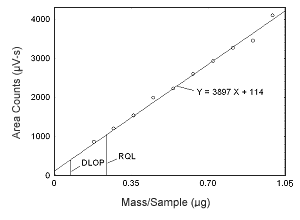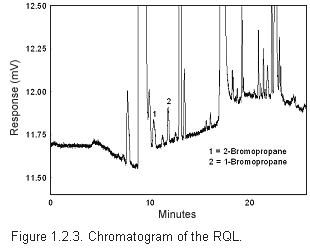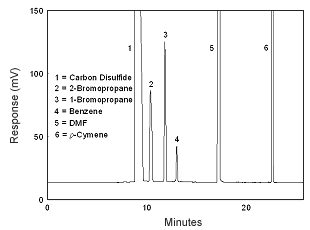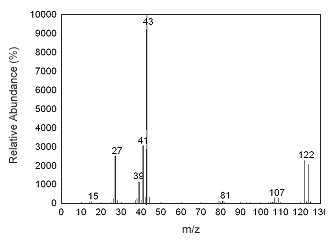2-Bromopropane
| Method number: | PV2062 |
| Matrix: | Air |
| Target concentration: | 5 ppm (25.14 mg/m3) |
| Procedure: | Samples are collected by drawing a known volume of air through standard size (6-mm o.d.,100/50-mg sections) coconut shell charcoal (CSC) tubes. Samples are desorbed with a mixture of 99/1 (v/v) carbon disulfide (CS2)/dimethylformamide (DMF) and analyzed by gas chromatography (GC) using a flame ionization detector (FID). |
| Recommended air volumes and sampling rate: |
12 L at 0.1 L/min |
| Reliable quantitation limit: | 0.004 ppm (0.020 mg/m3) |
| Status of method: | Partially Evaluated Method. This method has been subjected to established evaluation procedures, and is presented for information and trial use. |
| Date: March 10, 1999 | Chemist: Wayne Potter |
Organic Service Branch I
OSHA Salt Lake Technical
Center
Salt Lake City, UT 84115-1802
1. General Discussion
1.1 Background
1.1.1 History
The OSHA Salt Lake Technical Center recently received a set of
field samples that requested analysis for
1.1.2 Toxic effects (This section is for information only and should not be taken as the basis of OSHA policy.)
A recent case study on the mass intoxication of workers at an
electronic factory in Korea indicated that
1.1.3 Workplace exposure (Ref. 5.2)
2-bromopropane has been used mostly as an intermediate for medicines and pesticides. It is also used as a substitute for Freon 113 as a cleaning solution in the process of assembling tactile switches in an electronics product factory.
1.1.4 Physical properties and other descriptive information (Ref.
5.3 unless otherwise indicated).
| Synonyms: | Isopropyl bromide |
| CAS number: | 75-26-3 |
| IMIS: | R289 |
| RTECS: | TX4111000 (Ref. 5.4) |
| Molecular weight: | 123.0 (Ref. 5.2) |
| Boiling point: | 59.0°C |
| Melting point: | -89.0°C |
| Flash point: | 22°C (72°F) (CC) (Ref. 5.4) |
| Vapor pressure: | 236.3 mm Hg @ 25°C |
| Density: | 1.31 @ 20°C |
| Properties: | Clear, colorless to slightly yellow flammable liquid. |
| Solubility: | 0.286 wt% in water (18°C), soluble in acetone, methanol, carbon tetrachloride, carbon disulfide and aromatic hydrocarbons. (Ref. 5.2) |
| Molecular formula: | C3H7Br |
| Structural formula: |
The analyte air concentrations throughout this method are based on the recommended sampling and analytical parameters. Air concentrations listed in ppm are referenced to 25°C and 101.3 kPa (760 mmHg).
1.2 Limit defining parameters
1.2.1 Detection limit of the overall procedure (DLOP)
The detection limit of the overall procedure is 0.13 µg per sample (0.002 ppm or 0.011 mg/m3). This is the amount of analyte spiked on the sampler that will give a response that is significantly different from the background response of a sampler blank.
The DLOP is defined as the concentration of analyte that gives a response (YDLOP) that is significantly different (three standard deviations (SDBR)) from the background response (YBR).
YDLOP - YBR = 3(SDBR)
The direct measurement of YBR and
SDBR in chromatographic methods is
typically inconvenient, and difficult because
YBR is usually extremely low. Estimates of
these parameters can be made with data obtained from the analysis of
a series of samples whose responses are in the vicinity of the
background response. The regression curve obtained for a plot of
instrument response versus concentration of analyte will usually be
linear. Assuming SDBR and the precision of
data about the curve are similar, the standard error of estimate
(SEE) for the regression curve can be substituted for
SDBR in the above equation. The following
calculations derive a formula for the DLOP:

| Yobs | = | observed response |
| Yest | = | estimated response from regression curve |
| n | = | total no. of data points |
| k | = | 2 for a linear regression curve |
At point YDLOP on the regression curve
| YDLOP = A(DLOP) + YBR | A = analytical sensitivity (slope) |
therefore
| DLOP = | (YDLOP -
YBR)
A |
Substituting 3(SEE) + YBR for YDLOP gives
| DLOP = | 3(SEE)
A |
The DLOP is measured as mass per sample and expressed as
equivalent air concentrations, based on the recommended sampling
parameters. Ten samplers were spiked with equal descending
increments of analyte, such that the highest sampler loading was
0.995 µg/sample. This is the amount, when spiked on a sampler, that
would produce a peak approximately 10 times the background response
for the sample blank. These spiked samplers, and the sample blank
were analyzed with the recommended analytical parameters, and the
data obtained used to calculate the required parameters (A and SEE)
for the calculation of the DLOP. Values of 3897 and 93.4 were
obtained for A and SEE respectively. DLOP was calculated to be 0.072
µg/sample (0.001 ppm or 0.006
mg/m3).
|
 Figure 1.2.1. Plot of data to determine the DLOP/RQL. | |||||||||||
1.2.2 Reliable quantitation limit (RQL)
The reliable quantitation limit is 0.24 µg per sample (0.004 ppm or 0.020 mg/m3). This is the amount of analyte spiked on a sampler that will give a signal that is considered the lower limit for precise quantitative measurements.
 The
RQL is determined from the regression line data obtained for the
calculation of the DLOP (Section 1.2.1), providing at least 75% of
the analyte is recovered. The RQL is defined as the concentration of
analyte that gives a response (YRQL) such
that
The
RQL is determined from the regression line data obtained for the
calculation of the DLOP (Section 1.2.1), providing at least 75% of
the analyte is recovered. The RQL is defined as the concentration of
analyte that gives a response (YRQL) such
that
YRQL - YBR = 10(SDBR)
therefore
| RQL = | 10(SEE)
A |
RQL = 0.24 µg per sample (0.020
mg/m3)
The recovery at the RQL is
96.4%.
2. Sampling Procedure
2.1 Apparatus
2.1.1 Samples are collected using a personal sampling pump calibrated, with the sampling device attached, to within ±5% of the recommended flow rate.
2.1.2 Samples are collected using solid sorbent sampling tubes
containing coconut shell charcoal (CSC). Each tube consists of two
sections of charcoal separated by a urethane foam plug. The front
section contains 100 mg of charcoal and the back section, 50 mg. The
sections are held in place with glass wool plugs in a glass tube
2.2 Technique
2.2.1 Immediately before sampling, remove the caps from the sampling tubes. All tubes should be from the same lot.
2.2.2 Attach the sampling tube to the pump with flexible tubing. It is desirable to utilize sampling tube holders which have a protective cover to sheild the employee from the sharp, jagged end of the sampling tube. Position the tube so that sampled air passes through the front section of the tube first.
2.2.3 Air being sampled should not pass through any hose or tubing before entering the sampling tube.
2.2.4 Attach the sampler vertically with the front section pointing downward, in the worker's breathing zone, and positioned so it does not impede work performance or safety.
2.2.5 After sampling for the appropriate time, remove the sample
and seal the tube with plastic end caps. Wrap each sample
2.2.6 Submit at least one blank sample with each set of samples. Handle the blank sampler in the same manner as the other samples except draw no air through it.
2.2.7 Record the sample volume (in liters of air) for each sample, along with any potential interferences.
2.2.8 Ship any bulk samples in separate containers from the air samples.
2.2.9 Submit the samples to the laboratory for analysis as soon as possible after sampling. If delay is unavoidable, store the samples in a refrigerator.
2.3 Desorption efficiency
The desorption efficiency of
|
| ||||
| Tube # | % Recovered | |||
| 0.1 × 30.16µg |
0.5 × 150.8µg |
1.0 × 301.6µg |
2.0 × 603.2µg | |
|
| ||||
| 1 2 3 4 5 6 |
104.8 101.7 103.6 100.0 106.5 97.8 102.4 |
100.9 96.9 96.8 97.3 96.4 99.4 98.0 |
100.0 99.9 97.7 99.5 99.3 99.5 99.3 |
97.6 99.1 100.1 99.6 98.9 98.8 99.0 |
| overall |
99.7 | |||
| SD | ±1.90 | |||
|
| ||||
2.4 Retention efficiency
The sampling tubes were spiked with 603.2 µg (50.3
mg/m3 based on a 12 L air sample)
|
| |||
| Tube # | Front Section | Back Section | Total |
|
| |||
| 1 2 3 4 5 6 |
76.2 74.6 71.8 75.8 74.2 73.2 |
23.1 24.4 27.7 23.5 24.2 24.8 |
99.3 99.0 99.5 99.3 98.4 98.0 |
| 98.9 | |||
|
| |||
2.5 Sample storage
The adsorbing sections of
|
| ||||
| Ambient Storage
|
Refrigerator Storage
| |||
| Time (days) | % Recovered | Time (days) | % Recovered | |
|
| ||||
| 7 7 7 7 7 7 15 15 15 15 15 15 |
99.5 101.9 100.8 98.2 98.4 96.4 99.9 97.7 99.5 98.3 97.8 98.5 98.9 |
7 7 7 7 7 7 15 15 15 15 15 15 |
99.9 101.7 98.8 97.1 102.2 101.5 99.3 100.0 101.3 99.5 98.5 103.5 100.3 | |
|
| ||||
2.6 Recommended air volume and sampling rate.
Based on the data collected in this evaluation, 12 L air samples should be collected at a sampling rate of 0.1 L/min.
2.7 Interferences (sampling)
2.7.1 It is not known if any compounds will severely interfere
with the collection of
2.7.2 Suspected interferences should be reported to the laboratory with submitted samples.
2.8 Safety precautions (sampling)
2.8.1 Attach the sampling equipment to the worker in such a manner that it will not interfere with work performance or safety.
2.8.2 Follow all safety practices of the Chemical Hygiene Plan that apply to the work area being sampled.
2.8.3 Wear eye protection at all times while in the work areas.
3. Analytical Procedure
3.1 Apparatus
3.1.1 A gas chromatograph equipped with a flame ionization detector. A Hewlett Packard model 5890 was used in this study.
3.1.2 A GC column capable of separating the analyte from any
interferences. The column used in this study was a 60-meter
3.1.3 An electronic integrator or some suitable method of measuring peak areas. A Hewlett Packard model 3396A and the Waters Millennium Data System was used in this study.
3.1.4 Four milliliter vials with Teflon-lined caps.
3.1.5 A 10-µL syringe or other convenient size for sample injection.
3.1.6 Pipets for dispensing the desorbing solution. A
3.1.7 Volumetric flasks -
3.1.8 A balance for weighing
3.2 Reagents
3.2.1 GC grade nitrogen, hydrogen and air.
3.2.2 2-Bromopropane (CAS 75-26-3). 2-Bromopropane, 99+%, was obtained from Aldrich Chemical Company, Lot 01220ER.
3.2.3 Carbon disulfide (CAS 75-15-0). Carbon Disulfide, 99.99%, was obtained from EM Science, Lot 970338.
3.2.4 N,N-Dimethyl formamide (CAS 68-12-2).
3.2.5 r-Cymene (CAS 99-87-6). r-Cymene, 99%, was obtained from Aldrich Chemical Company, Lot 11703TR.
3.2.6 The desorbing solvent consists of 99/1 (v/v) carbon disulfide/N,N-dimethyl formamide containing r-cymene internal standard at a concentration of 0.25 µL/mL.
3.3 Standard preparation
3.3.1 At least two separate stock standards are prepared by
weighing a quantity of
3.3.2 Dilutions of these stock standards were prepared to bracket the samples. The range of the standards used in this study was from 30.16 to 603.2 µg/mL.
3.4 Sample preparation
3.4.1 Sample tubes are opened and the front section and back
section of each tube are placed in separate
3.4.2 Each section is desorbed with 1 mL of desorbing solution.
3.4.3 The vials are sealed immediately and allowed to desorb for one hour on a mechanical rotator or the vials are shaken vigorously by hand several times during the desorption time.
3.5 Analysis
3.5.1 Gas chromatograph conditions.
| Injection size: |
1 µL |
| Flow rates (mL/min)
| |
| Nitrogen (make-up): | 30 |
| Hydrogen (carrier): | 2 |
| Hydrogen (detector): | 40 |
| Air: |
420 |
| Temperatures (°C)
| |
| Injector: | 200 |
| Detector: | 275 |
| Column: | 45 °C for 4 min, 10°/min to 200 °C, hold for 8 min at 200 °C. |
| Chromatogram: |  Figure 3.5.1 Chromatogram at the target concentration. |
3.5.2 Peak areas are measured by an integrator or other suitable means.
3.6 Interferences (analytical)
3.6.1 Any compound that produces an FID response and has a
similar retention time as the analyte is a potential interference.
If any potential interferences were reported, they should be
considered before samples are desorbed. Generally, chromatographic
conditions can be altered to separate an interference from the
analyte. Using the analytical conditions in this method,
3.6.2 When necessary, the identity or purity of an analyte peak may be confirmed by a GC-mass spectrometer or by another analytical procedure.

Figure 3.6.2 Mass
spectra of 2-bromopropane
3.7 Calculations
3.7.1 The calibration curve was made from at least four standards at different concentrations bracketing the samples.
3.7.2 The values for the samples are obtained from the calibration curve.
3.7.3 To calculate the concentration of analyte in the air sample
the following formulas are used:
| (µg/mL) (desorption volume)
(desorption efficiency) |
= mass of analyte in sample |
| (mass of analyte in sample)
molecular weight |
= number of moles of analyte |

| (volume analyte occupies)
(106) *
(air volume) |
= ppm |
* All units must cancel.
3.7.4 The above equations can be consolidated to the following
formula.
| (µg/mL) (DV) (24.46)
(106) (g) (mg)
(Liters)(DE) (MW)(1000mg)(1000µg) |
= ppm |
| µg/mL | = Concentration of analyte in sample or standard |
| 24.46 | = Molar volume (liters/mole) at 25°C and 760mm Hg |
| MW | = Molecular weight (µg/mole) |
| DV | = Desorption volume |
| Liters | = Liters of air sample |
| DE | = Desorption efficiency |
3.7.5 To calculate the mg/m3 of analyte
in the sample:
| (µg/mL) (DV) (mg) (1000 L)
(Liters) (DE) (1000 µg) (m3) |
= mg/m3 |
where:
| µg/mL | = Concentration of analyte in sample or standard |
| DV | = Desorption volume |
| Liters | = Liters of air volume |
| DE | = Desorption efficiency |
3.7.6 This calculation is done for each section of the sampling tube and the results added together after a blank correction is performed, if necessary.
3.8 Safety precautions
3.8.1 Adhere to the rules set down in your Chemical Hygiene Plan (which is mandated by the OSHA laboratory standard).
3.8.2 Avoid skin contact and inhalation of all chemicals.
3.8.3 Wear safety glasses, gloves and a lab coat at all times while in the laboratory areas.
4. Recommendations for Further Study
Collection studies should be performed with controlled test atmospheres.
5. References
5.1 Yu, J., Y. Chung, C. Lim, S. Maeng, J. Lee,
H. Kim, S. Lee, C. Kim, T. Kim, C. Lim, J. Park and Y. Moon:
Reproductive Toxicity of
5.2 Takeuchi, Y., G. Ichihara and M. Kamijima:
A Review on Toxicity of
5.3 OSHA Computerized Information System
Database, Material Safety Data Sheets (CCOHS Trade Names) Database;
5.4 Sweet, D., "Registry of Toxic Effects of
Chemical Substances",